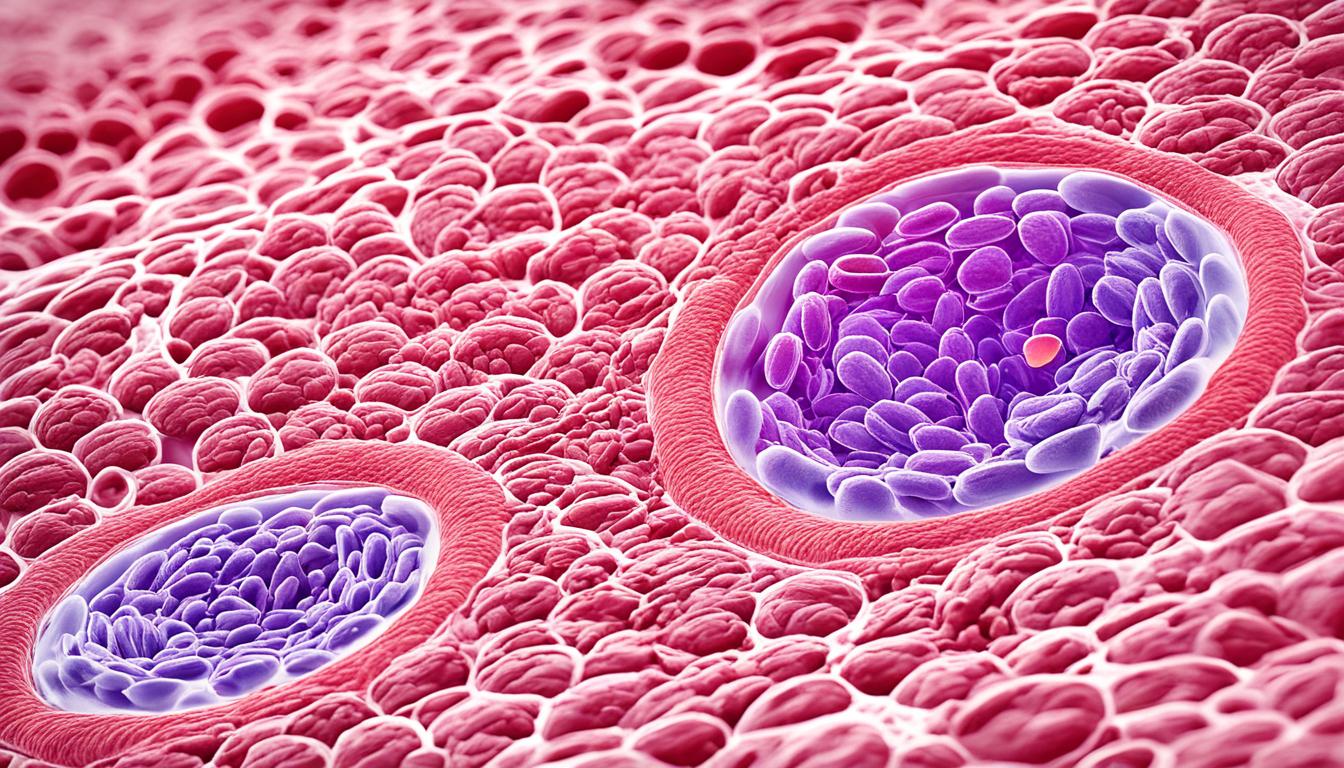Coarctation of the aorta is a heart defect found at birth. It makes the aortic isthmus narrow. About 1 in 2500 babies get it, with boys more likely to have it. Often, it’s spotted when babies are little. They might get sick quickly or just during a check-up.
If caught early, surgery is the top fix. For older kids and adults, doctors might use a less invasive method with a small tube called a stent.
After treatment, many still face a risk of high blood pressure. This condition can cause more health problems and, sometimes, shorter life.
Scientists are looking into new ways to help, like using stem cells. This could open up more chances to fight this heart problem effectively.
Key Takeaways:
- Coarctation of the aorta is a congenital heart defect characterized by a narrowing of the aortic isthmus.
- Surgical repair is the primary treatment for infants, while transcatheter management with endovascular stenting is preferred for older patients.
- Hypertension is a significant risk for patients with coarctation of the aorta, even after successful repair.
- Stem cell therapy shows promise as a potential treatment option for coarctation of the aorta.
- Further research is needed to determine the safety and efficacy of stem cell therapy for coarctation of the aorta.
Symptoms of Coarctation of the Aorta
The symptoms of coarctation of the aorta change with the narrowing’s severity. Infants may have trouble feeding, gain weight slowly, and have lower leg blood pressure. For older kids and adults, high blood pressure, headaches, and cold feet are common. Other signs include different blood pressure in arms and legs, a heart murmur, and weak pulses in legs.
If aortic narrowing affects the aortic isthmus, it limits blood to the lower body. This can lower leg blood pressure compared to the arms. Such blood pressure differences are key signs of coarctation of the aorta.
Babies with coarctation might feed poorly, gain weight slowly, and have lower leg blood pressure. They may also show weak pulses in their legs. If untreated, this condition can cause heart failure and other severe issues.
Older children and grown-ups with a narrowing aorta may face high blood pressure, headaches, and cold feet. They could also have a heart murmur from the narrowed aorta. Not all patients show symptoms early, stressing early screening and diagnosis.
| Age Group | Symptoms |
|---|---|
| Infants | Difficulty feeding Poor weight gain Low blood pressure in legs compared to arms Weaker or absent pulses in lower extremities |
| Children and Adults | High blood pressure Headaches Leg cramps Cold feet Heart murmur |
Causes and Diagnosis of Coarctation of the Aorta
Potential Causes
The cause of coarctation of the aorta is not fully known. It seems to come from genes and the environment. Genetic conditions like Turner syndrome raise the risk of developing this heart issue. It can also happen if someone in the family has had it.
Diagnosis
Doctors check for coarctation of the aorta by doing a physical exam. A specialist looks at the patient’s blood pressure, pulse, and listens for a heart murmur.
If the doctor suspects an issue, they may order more tests to confirm. They want to know how badly the aorta is narrowed and exactly where.
- Echocardiography: This test is safe and shows the heart’s details using sound waves. It helps find issues in the aorta.
- Magnetic Resonance Imaging (MRI): MRI scans your heart without surgery. It gives clear images to locate the narrowing.
- Computed Tomography (CT) Scans: CT scans take many X-rays to provide detailed body pictures. This helps doctors check the aorta’s condition.
Spotting coarctation of the aorta early is key for good treatment. Early care can avoid problems and make a patient’s life better in the long run.
| Potential Causes | Diagnosis Methods |
|---|---|
| Combination of genetic and environmental factors | Physical examination |
| Genetic conditions, such as Turner syndrome | Echocardiography |
| Magnetic Resonance Imaging (MRI) | |
| Computed Tomography (CT) Scans |
The Promise of Stem Cell Therapy for Coarctation of the Aorta
Stem cell therapy is a new way to treat coarctation of the aorta. This is a serious heart problem where the aorta is narrow. Recent studies show that stem cells, especially those from bone marrow or fat, can help fix heart damage. They might make the heart work better too.
Stem cells are amazing because they can become any type of cell. This includes cells that keep our blood vessels strong. Tests on animals have shown that this therapy can make the aorta less narrow. It also helps blood move better through vessels.
Yet, we need more research to be sure stem cell therapy is safe and really works for this heart issue. Experts are working hard to learn more. They want to see how well stem cells can help with this tough problem.

